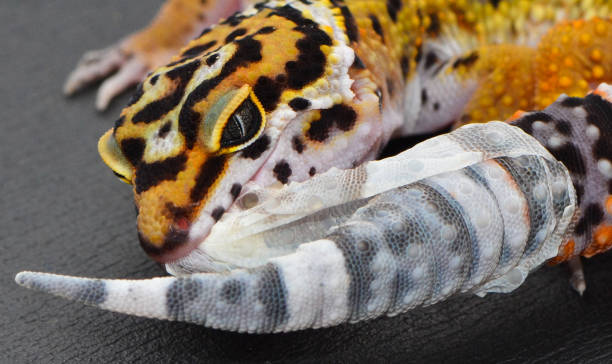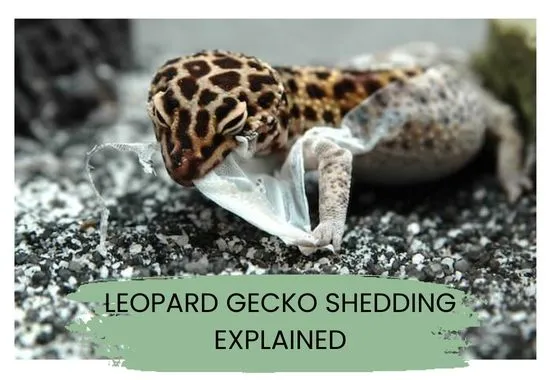Leopard geckos are a popular pet reptile known for their docile nature and hardy constitution. They are relatively low maintenance, easy to handle and have a lifespan of up to 20 years with proper care.
One of the most significant aspects of caring for a leopard gecko is understanding the shedding process. In this article, we will explore the basics of leopard gecko shedding, including why it happens, how often it occurs, and how to properly support your gecko during the shedding process.
We’ll also discuss some common shedding issues and how to address them. By understanding the shedding process, you can help ensure that your leopard gecko stays healthy and happy for years to come.

How often do leopard geckos shed?
Leopard geckos shed their skin regularly as they grow and mature. Adult leopard geckos shed every 4-6 weeks. However, shedding frequency can vary depending on factors such as the gecko’s growth rate, overall health, and environmental conditions.
Some leopard geckos may shed more frequently if they are experiencing stress or if their enclosure is too dry. Therefore, it’s important to maintain proper humidity levels and to provide a shedding box or hide filled with moist moss or coconut fiber to help the gecko shed its skin easily.

How often do baby leopard geckos shed?
Baby leopard geckos typically shed more frequently than adult geckos. They may shed every 1-2 weeks, or even more frequently as they are growing rapidly.
Why do leopard geckos shed?
Leopard geckos shed their skin as a normal part of their growth and development. As they grow, their skin becomes too tight and restrictive, making it difficult for them to move and function properly. Shedding allows the gecko to shed this restrictive skin and reveal a new, larger layer of skin beneath. Additionally, shedding helps to remove any parasites, bacteria, or other debris that may be stuck to their skin.
Another reason for shedding is that, as the gecko grows, their skin may become damaged or worn. Shedding can help to remove any damaged or worn skin and reveal a new, healthy layer underneath.
Lastly, shedding also helps leopard geckos to keep their camouflage and coloration. As they shed, the pigmentation of their skin may change, allowing them to better blend in with their surroundings and stay hidden from predators.
How long does it take for a leopard gecko to shed?
The shedding process for leopard geckos typically takes several days.
Leopard gecko shedding signs:
- The gecko will first show signs of shedding, such as becoming less active, becoming more irritable and developing a dull, opaque appearance to their skin.
- Then the gecko will begin to rub and scratch at its skin in order to loosen the shed.
- Once the shed has loosened, the gecko will begin to peel it off, starting from the tail and working its way towards the head.
- The entire process can take anywhere from a few days to a week, depending on the size of the shed and the gecko’s individual shedding rate.
Do leopard geckos stop eating when they shed?
Leopard geckos may reduce their food intake or stop eating altogether during the shedding process. This is normal as the shedding process can be taxing for the gecko and they may not be as active or have an appetite. Additionally, the gecko may be using energy to shed its skin, instead of digesting food.
Is there a shedding season for leopard geckos?
Leopard geckos do not have a specific shedding season. They shed their skin regularly as they grow and mature, and shedding frequency can vary depending on factors such as the gecko’s growth rate, overall health, and environmental conditions.
If the gecko does not start eating again after shedding, or if you notice any other abnormal behavior or health issues, it’s best to consult a veterinarian.
Can you hold a leopard gecko when it’s shedding?
It is generally not recommended to hold a leopard gecko when it is shedding. During the shedding process, leopard geckos can become irritable and stressed, and they may be more prone to biting or scratching. Additionally, the shedding skin can be easily damaged or removed if the gecko is handled, which can cause the shedding process to take longer or lead to health problems.
It’s best to give your leopard gecko some space and privacy while it’s shedding. Provide a shedding box or hide filled with moist moss or coconut fiber to help the gecko shed its skin easily. If you need to handle your gecko during shedding, you can use a moistened cotton swab to gently rub the shedding skin to help it come off, but be very gentle and do not pull the skin.
Why does my leopard gecko eat its old skin?
It is not uncommon for leopard geckos to eat their old skin after shedding. This behavior is called autophagia, and it is believed to be a natural and instinctual behavior. Eating their old skin can help leopard geckos to obtain nutrients and minerals that are left behind on the shed skin. This can also help to keep their enclosure clean as they are eating their old skin, which can prevent bacterial and fungal growth.
It’s also important to note that if your leopard gecko has a healthy diet and is getting all the necessary nutrients, it may not eat its old skin. Some geckos may not eat their old skin at all, or only eat a small portion of it.
What to do if my leopard gecko has stuck skin?
If your leopard gecko has stuck skin, there are a few things you can do to help it shed properly:
- Increase humidity: Stuck skin can be caused by low humidity levels, so it’s essential to increase the humidity in your gecko’s enclosure. This can be done by misting the enclosure with water, adding a water dish, or providing a shedding box or hide filled with moist moss or coconut fiber.
- Gently rub the stuck skin: You can use a moistened cotton swab or a warm, damp washcloth to gently rub the stuck skin. This can help to loosen it and make it easier for the gecko to shed. Be very gentle and do not pull the skin.
- “Soak” your leopard gecko: You can also try soaking your gecko in warm water for about 10–15 minutes. This can help to soften the stuck skin and make it easier to remove. Important: you should never submerge your gecko underwater! If your gecko feels uncomfortable or stressed by stepping in water, take it out immediately and try some other method, such as using a wet cotton bud.
- Provide a warm hide: Make sure your gecko has access to a warm hide, as a warm and humid environment can help the gecko shed its skin easily.
- Consult a veterinarian: If you notice any abnormal shedding patterns or if your gecko seems to be having difficulty shedding, it’s important to consult a veterinarian, as it may indicate a health issue.

It’s critical to be patient and gentle when helping your gecko shed its skin. If you’re not comfortable or familiar with the process, it’s best to consult a veterinarian or an experienced reptile keeper to help.
